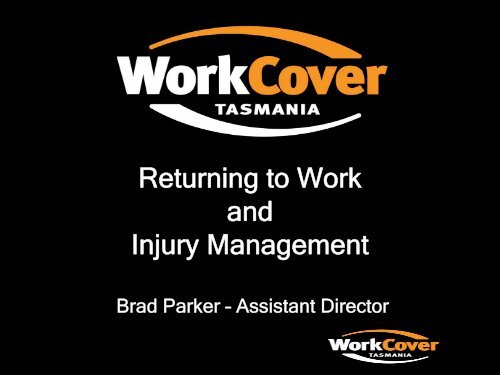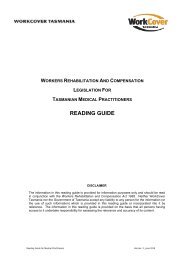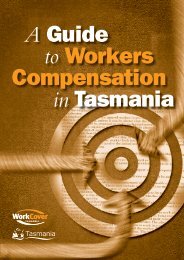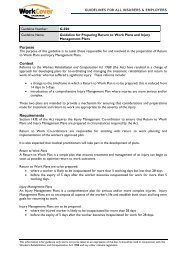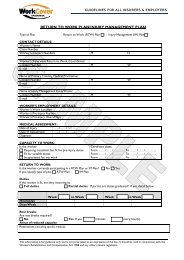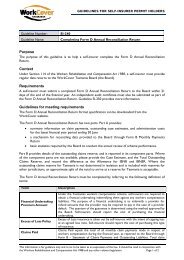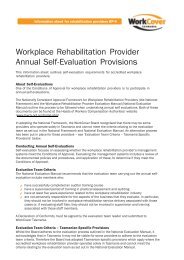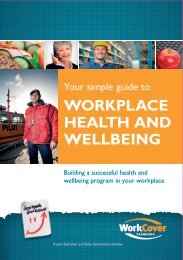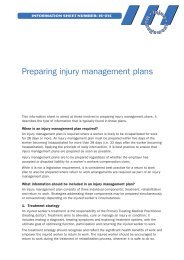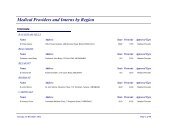Return to work - Employer and Worker Presentation - WorkCover ...
Return to work - Employer and Worker Presentation - WorkCover ...
Return to work - Employer and Worker Presentation - WorkCover ...
You also want an ePaper? Increase the reach of your titles
YUMPU automatically turns print PDFs into web optimized ePapers that Google loves.
<strong>Return</strong>ing <strong>to</strong> Work<strong>and</strong>Injury ManagementBrad Parker – Assistant Direc<strong>to</strong>r
Disclaimer• The information ("Information") prepared for this presentation has beenprepared <strong>and</strong> supplied in good faith on behalf of the Crown in Right ofTasmania ("the Crown") by the Department of Justice <strong>and</strong> <strong>WorkCover</strong>Tasmania ("the Board").• Although all due care <strong>and</strong> attention has been taken in preparing <strong>and</strong>collating the information neither the Crown nor the Board gives awarranty either express or implied as <strong>to</strong> the accuracy or completeness ofthe Information or its relevance <strong>to</strong> any particular circumstances.• The Information may change or be varied due <strong>to</strong> facts or requirements ofdifferent areas of government or policy issues in existance but notknown or apparent <strong>to</strong> those preparing or collating the Information.• The Crown <strong>and</strong> the Board <strong>and</strong> their relevant employees <strong>and</strong> agentsaccept no liability (whether by reason of negligence or otherwise) <strong>to</strong> anyperson for any damage or loss whatsoever or howsoever arising orsuffered as a consequence of the use or reliance on the Information oradvice given on this website which is used or relied on at that person'sown risk absolutely.
What we will cover <strong>to</strong>day• Health Benefits of Work• Injury Management• Important changes in the way you manage<strong>work</strong>place injuries• Medical certificates• Injury Management Process• Importance of alternative duties• Injury management systems <strong>and</strong> some take awayactions• Q & A session
Consequences of Being Off Work• Health Risk = smoking 10packs of cigarettes per dayBeing out of<strong>work</strong> forextendedperiods of time isbad for aperson’s health• Suicide in young men > 6months out of <strong>work</strong>increased x 40• Suicide rate in generalincreased x 6 in longer-term<strong>work</strong>lessness• Health risk <strong>and</strong> lifeexpectancy greater thanmany “killer diseases”• Greater risk than mostdangerous jobs
Benefits of Work•Earlier this year the Australasian Faculty of Occupational<strong>and</strong> Environmental Medicine released its Australian <strong>and</strong>New Zeal<strong>and</strong> Consensus Statement on the Health Benefitsof Work.•Some of the Consensus Statement’s fundamental principlesare:• <strong>work</strong> is generally good for health <strong>and</strong> wellbeing• long-term <strong>work</strong> absence have a negative impac<strong>to</strong>n health <strong>and</strong> wellbeing• attempting <strong>to</strong> return <strong>to</strong> <strong>work</strong> after injury or illnessface a complex situation• good outcomes are more likely when peopleunderst<strong>and</strong> the health benefits of <strong>work</strong>, <strong>and</strong> areempowered <strong>to</strong> take responsibility for their ownsituation<strong>WorkCover</strong> hassigned up as asupporter of theConsensusStatement <strong>and</strong> itsrecommendations
Consequences of Being Off Work10.90.80.70.60.50.40.30.20.100 50 100 150 200 250 300 350 400Days (t)Figure 1. Likelihood of return <strong>to</strong> <strong>work</strong> after various length of time off <strong>work</strong>The longer someone spends away from <strong>work</strong>, theless likely they will ever return
Psychological <strong>and</strong> Social Impactson the <strong>Worker</strong>Psychosocial{impacts of<strong>work</strong> absence• Depression• Erosion of skills• Decreased income <strong>and</strong>social status• Loss of social supportnet<strong>work</strong>s• Decreased confidence• Decreased sense of selfefficacy
What is Injury Management?Injury management encompasses thoseactivities which directly affect an injured<strong>work</strong>er’s recovery, including themanagement of:• medical treatment• rehabilitation• returning <strong>to</strong> <strong>work</strong>• the relationships between those involved
July 2010 Amendments <strong>to</strong> the Act• The RTW & IMM provides a frame<strong>work</strong> for improving <strong>and</strong>streamlining the management of <strong>work</strong>place injury <strong>and</strong>illness <strong>and</strong> aims <strong>to</strong> deliver better health <strong>and</strong> return <strong>to</strong> <strong>work</strong>outcomes for injured <strong>work</strong>ers• Amendments provided the necessary legislative frame<strong>work</strong><strong>to</strong> implement the <strong>Return</strong> <strong>to</strong> Work <strong>and</strong> Injury ManagementModel (RTW & IMM)
Principles of ModelThere are seven high-level principles underlyingthe model:1. Shared commitment2. Early intervention3. Focus on the injured <strong>work</strong>er <strong>and</strong> employer4. Transparent, cost efficient <strong>and</strong> effective5. Access <strong>to</strong> information <strong>and</strong> support6. High st<strong>and</strong>ard of injury management7. Timely, facilitated resolution of issues
Implementation of ModelImplementation of the model required…• July 2010 – Introduction of new legislativeprovisions• Introduction of new claim form <strong>and</strong> <strong>work</strong>ersCompensation medical certificates• Development of GP education strategy• Educational <strong>and</strong> promotional material <strong>and</strong>activities
July 2010 Key Amendments<strong>Employer</strong> Injury ManagementProgramsA series of documented policies <strong>and</strong>procedures that establish aco-ordinated <strong>and</strong> integrated processfor injury management<strong>Employer</strong>s required <strong>to</strong> have an IMPin place <strong>and</strong> operate in accordancewith itIMP may be developed by the employeror alternatively the insurer’s IMP maybe usedIMPs aim <strong>to</strong> achieve a sharedcommitment <strong>to</strong> the injuryManagement process
Injury Management ProgramsConsultation will occur:• Developing <strong>and</strong> implementing <strong>work</strong>place health<strong>and</strong> safety system,• preparing <strong>and</strong> maintaining injury managementprograms,• developing an injury management policy <strong>and</strong>associated processes• When regularly moni<strong>to</strong>ring <strong>and</strong> evaluating theeffectiveness of <strong>work</strong>place injury managementprograms against outcomes
July 2010 Key Amendments<strong>Return</strong> <strong>to</strong> Work PlansA simple plan for co-ordinating <strong>and</strong>managing treatment, rehabilitation<strong>and</strong> return <strong>to</strong> <strong>work</strong>The IMC must ensure that a RTWPlan is prepared where a <strong>work</strong>erIs likely <strong>to</strong> be incapacitated for more than5 <strong>work</strong>ing daysReducing the requirement for RTWPlans <strong>to</strong> be completed from 14 days<strong>to</strong> 5 days ensures that RTW willcommence without delayInjury Management PlansA comprehensive planThe IMC <strong>to</strong> ensure that a IM Plan isprepared where the injured <strong>work</strong>er islikely <strong>to</strong> be incapacitated for morethan 28 daysThe introduction of two types ofplans ensures that considerations<strong>and</strong> preparations for RTW areappropriate <strong>to</strong> the severity of theinjury
RTW Plans & IM PlansIM Plan – Moderate <strong>to</strong> high severityInjury SeverityINJURYOCCURSInjury Management PlanTreatmentRecovery LineRehabilitationPsychosocial Fac<strong>to</strong>rsLevel of <strong>Employer</strong> Involvement<strong>Return</strong> <strong>to</strong> Work Plan<strong>Return</strong> <strong>to</strong> Work• Treatment – largeRehabilitation – moderate<strong>Return</strong> <strong>to</strong> <strong>work</strong> - small• <strong>Employer</strong> involvement initially smallbut increases with time• Doc<strong>to</strong>r involvement initially large butdecreases with timeRTW Plan – Low severity• Treatment – smallRehabilitation - moderate<strong>Return</strong> <strong>to</strong> <strong>work</strong> - large• <strong>Employer</strong> involvement large <strong>and</strong>increases with time• Doc<strong>to</strong>r involvement small <strong>and</strong>decreases with timeLevel of Doc<strong>to</strong>r Involvement
July 2010 Amendments <strong>to</strong> the ActInjury Management Co-ordina<strong>to</strong>rAn IMC is a person responsible forco-ordinating <strong>and</strong> overseeing theentire injury management process<strong>Employer</strong>s who choose <strong>to</strong> developtheir IMP must appoint an IMCWhere the employer uses theirinsurer’s IMP the role will resideWith the insurerRole of IMC aims <strong>to</strong> streamline themanagement of <strong>work</strong>place injuriesby improving co-ordination <strong>and</strong>providing a central contact for allpartiesThe existing RehabilitationCo-ordina<strong>to</strong>r role will remain but thetitle has been changed <strong>to</strong> ‘<strong>Return</strong><strong>to</strong> Work Co-ordina<strong>to</strong>r <strong>to</strong> better reflectthe nature of the role <strong>and</strong>relationship with the IMC
July 2010 Key AmendmentsWorkplace Rehabilitation Providers<strong>to</strong> be accredited by <strong>WorkCover</strong>Accreditation system for WRP has beenestablishedTo ensure the delivery of consistent<strong>and</strong> high quality <strong>work</strong>placerehabilitation services
Where does the RTWC role fit?NewRole
July 2010 Key AmendmentsEarly InterventionEnsures that injuries are reportedEarly, so that treatment <strong>and</strong>Management of the injury canCommence as soon as possible<strong>Employer</strong>s <strong>to</strong> notify insurer of an injuryWithin 3 <strong>work</strong>ing days<strong>Employer</strong> <strong>to</strong> provide <strong>work</strong>er with a‘notice of right <strong>to</strong> claim’ within 14 days<strong>Employer</strong>s <strong>to</strong> notify insurer of a claimWithin 3 <strong>work</strong>ing daysAll injury management provisions <strong>to</strong>Apply even if there is a dispute aboutliabilityEarly intervention has been shown<strong>to</strong> improve the likelihood of RTW<strong>and</strong> reduces the time required <strong>to</strong>do so
July 2010 Key Amendments<strong>Worker</strong>s <strong>to</strong> nominate PrimaryTreating Medical PractitionerAccreditation system for PTMP has beenestablishedTo ensure the delivery of consistent<strong>and</strong> high quality medical services
July 2010 Key AmendmentsA Primary Treating MedicalPractitioner is the MedicalPractitioner (usually the injured<strong>work</strong>er’s general practitioner)chosen by the injured <strong>work</strong>er <strong>to</strong>participate in the injurymanagement processCentral role <strong>and</strong> responsibilities ofPrimary Treating Medical PractitionervalidatedBy clearly defining the role of thePTMP, expectations can be clearlyseti.e. PTMP <strong>work</strong>ing with <strong>and</strong>collaborating with other key parties,in particular the employer
New <strong>Worker</strong>sCompensationMedicalCertificatesInitialCertificate
New <strong>Worker</strong>sCompensationMedicalCertificatesContinuing/FinalCertificate
The Injury Management ProcessWORKERDOCTOREMPLOYER• Seeks treatment• Notifies employerof injury ASAP• Issues medicalcertificate• Encouraged <strong>to</strong> contactthe employer• Must operate in accordanceWith approved IMP• Takes steps <strong>to</strong> preventreoccurrence• Notifies insurer of injury within<strong>work</strong>ing 3 days• Keeps in <strong>to</strong>uch with <strong>work</strong>er
The Injury Management ProcessEMPLOYERWORKEREMPLOYER• Supports <strong>work</strong>er• Provides injured<strong>work</strong>er with a ‘right <strong>to</strong>claim’ notice• Completes claim form• Gives claim form <strong>and</strong>medical certificate <strong>to</strong>employer• Notifies insurer of claimwithin 3 <strong>work</strong>ing days• Keeps in <strong>to</strong>uchwith injured <strong>work</strong>er
The Injury Management ProcessEMPLOYERWORKER• Insurer or employer <strong>to</strong> assign an IMC• <strong>Employer</strong> <strong>to</strong> appoint a RTWC (>50 <strong>work</strong>ers)• Provide <strong>work</strong>er with list of duties <strong>and</strong> position statementfor next Doc<strong>to</strong>r’s appointment• Keep employer up <strong>to</strong> date onprogress• To be involved in RTW planning• To actively participate in injurymanagement <strong>and</strong> RTW process• RTW Plan <strong>to</strong> be developed• Keep <strong>work</strong>er involved <strong>and</strong> up <strong>to</strong> date i.e. where possibleinvite <strong>to</strong> meetings <strong>and</strong> training, send out newsletters etc.
The Injury Management ProcessEMPLOYERWORKER• Plan for the <strong>work</strong>er’s RTW• Provide a supportive <strong>work</strong>environment for the <strong>work</strong>er <strong>to</strong> return <strong>to</strong>• Communicate with supervisors <strong>and</strong>colleagues• Support the <strong>work</strong>er in their return<strong>to</strong> <strong>work</strong>• To be involved in identificationof suitable duties• To <strong>work</strong> within the restrictionsprovided by the doc<strong>to</strong>r• To inform employer of anyissues or concerns asap
Alternative DutiesIt is expected that employers will:• Assist inidentifying timely<strong>and</strong> suitable <strong>and</strong>meaning duties
How Can <strong>Employer</strong>s AssistInjured <strong>Worker</strong>s?• Help create a supportive <strong>work</strong>place environment – optimistic <strong>work</strong>ers areless likely <strong>to</strong> experience frequency or intensity of injury• Encourage <strong>work</strong>er <strong>to</strong> be an active participant in return <strong>to</strong> <strong>work</strong>• Reinforce the benefit of <strong>work</strong> <strong>and</strong> the risks of being out of <strong>work</strong>• Encourage the injured <strong>work</strong>er <strong>to</strong> seek advice <strong>and</strong> explanation about theirhealth condition - leave them confident about self management• Work with the <strong>work</strong>er <strong>to</strong> identify suitable duties• Regularly communicate with the <strong>work</strong>er <strong>and</strong> encourage the <strong>work</strong>er <strong>to</strong>follow up with you as appropriate• Ensure that the <strong>work</strong>er has sufficient information• Be available <strong>to</strong> <strong>work</strong>ers <strong>to</strong> discuss any issues
How Injured <strong>Worker</strong>s CanInfluence RTW Outcomes• Be an active participant in return <strong>to</strong> <strong>work</strong>• Stay positive• Seek advice <strong>and</strong> explanation about your injury so that you can beconfident about self management• Work with employer <strong>to</strong> identify suitable duties• Suggest ways tasks can be modified <strong>to</strong> accommodate restrictions• Work within restrictions provided by doc<strong>to</strong>r - don’t risk re-injury• Regularly communicate with employer, especially when away from<strong>work</strong> – h<strong>and</strong> deliver medical certificate• Ensure that any issues or concerns are raised immediately
Look for opportunities <strong>to</strong> improveyour RTW System• Do your RTWCs need further training• Training of line managers <strong>and</strong> supervisors in injury management <strong>and</strong> communication.• The development of a system for obtaining regular feedback from <strong>work</strong>ers with an injury,such as routine surveys• Undertaking a group process <strong>to</strong> identify a list of modified duties for injured <strong>work</strong>ers.• Development of the organisation’s policies <strong>and</strong> procedures• Improved incident investigation.• Better systems of early reporting <strong>and</strong> communication• Specialist or external support for complex cases• The provision of ergonomic advice - improved relationships with health care providers• Prepare a written list of available modified duties• Improved communication channels for people returning <strong>to</strong> <strong>work</strong> – eg a weekly catch-up,<strong>and</strong> access <strong>to</strong> senior staff if there are problems• Regular reporting <strong>and</strong> feedback on the injury management system.• Regular meetings between the RTW coordina<strong>to</strong>r, relevant supervisors, HR <strong>and</strong> claimsstaff• The development of a tick box list of essential functions of particular jobs for treatingdoc<strong>to</strong>rs <strong>to</strong> complete• This list should be available on the company website so that employees can take it <strong>to</strong>their doc<strong>to</strong>rs
Further Resources<strong>WorkCover</strong> Tasmania Publicationshttp://www.<strong>work</strong>cover.tas.gov.au/resources• The Role of the <strong>Return</strong> <strong>to</strong> Work Co-ordina<strong>to</strong>r• The Role of the Primary Treating Medical Practitioner• The Role of the Injury Management Co-ordina<strong>to</strong>r• Injury Management: Making it Work• Register of Alternative Duties• Register of Training Providers• Injury Management Program Guidelines• Injury Management Policy Guidelines• <strong>Return</strong> <strong>to</strong> Work <strong>and</strong> Injury Management Plan Guidelines• <strong>Return</strong> <strong>to</strong> Work – Consensus Statement, on the Benefits of WorkTo Register with <strong>WorkCover</strong> as an IMC or RTWC go <strong>to</strong><strong>WorkCover</strong>’s website
Questions?
Thank you for your participationBrad Parker – Assistant Direc<strong>to</strong>r


